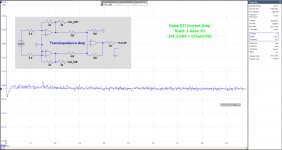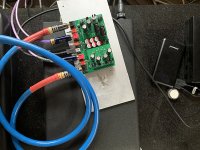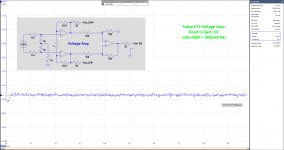And it also worked like promised with the SSM2220,
used to keep cost down.
Gerhard,
What a beautiful bullet proof casing did you use, machined out of one billet of aluminium.
Was this for a military application ?
Hans
No, microwave metrology.
You can get that stuff here: (sorry, Germany-centric)
< Home - Fischerelektronik - Suche >
< Hermetische Hochfrequenz-Gehause von SCHOTT fur Anwendungen bis zu 80 GHz | SCHOTT AG >
< Frasgehause >
Schott with the hermetic glass feedthroughs is probably over the top. 🙂
We once did an 300W RF amplifier and a technician made a hood for it from bent copper sheets. It was precise to 0.1 mm, but looked bad. Also cost a day in the workshop.
Then someone took an aluminium block, put it on the milling station and removed 90% of the material, but also made some stabilization ribs, logo, holes, threads etc. Also took a day in the workshop. The removed material went back to recycling. Any further hood took half an hour on the machine, unattended, looked good and was not too costly.
Now need some coffee first.
Gerhard
You can get that stuff here: (sorry, Germany-centric)
< Home - Fischerelektronik - Suche >
< Hermetische Hochfrequenz-Gehause von SCHOTT fur Anwendungen bis zu 80 GHz | SCHOTT AG >
< Frasgehause >
Schott with the hermetic glass feedthroughs is probably over the top. 🙂
We once did an 300W RF amplifier and a technician made a hood for it from bent copper sheets. It was precise to 0.1 mm, but looked bad. Also cost a day in the workshop.
Then someone took an aluminium block, put it on the milling station and removed 90% of the material, but also made some stabilization ribs, logo, holes, threads etc. Also took a day in the workshop. The removed material went back to recycling. Any further hood took half an hour on the machine, unattended, looked good and was not too costly.
Now need some coffee first.
Gerhard
Last edited:
OYG, my concern is not about the absolute value, but about the consistency. I got it bad (if you sifted through this thread) and I would like to find out what others get.
This is with one set of ZTX
This is with another set of ZTX, everything else being the same.
I see lots of these 2V5 capacitors and the low frequency noise that is f*cked up to varying degrees, with 1/f**3 or measured upwards from 100 Hz only where it could get interesting, combined with the high -3dB corner of the amplifier. And, as Hans has stated, powering it overnight can shift the effect/corner by 10 dB.
No one here has seen 1/f**3 from bare transistors, but from capacitors.
I re-cite Gallo on HIV, fighting esoteric cause-wannabes: You don't need cofactors when you're hit by a truck.
Others would call it Occam's Razor.
I think I'm through with that.
Gerhard
What happened with Richard ? It has been very quiet lately. I think he would like the modernised and differential John Curl design having about the same noise figure as his beautiful Duraglit and doesn’t have to be powered by a battery.
Hans
Hans
I have been using polymer caps in zener reference. And the current leakage is very high. And I suspect this leakage to be very variable over time giving this very high low frequency noise floor.
I would suggest to use Std caps... Panasonic for example. FC to get low esr values... In most cases it is the low esr that is important because we don't need MHz bandwidth in the frontend MC... A natural roll off would actually be desirable..
I would suggest to use Std caps... Panasonic for example. FC to get low esr values... In most cases it is the low esr that is important because we don't need MHz bandwidth in the frontend MC... A natural roll off would actually be desirable..
Second that. Exactly what I was trying to say. Polymer caps are for PSU decoupling, and better use those Panas you suggest for anything else, even cap multipliers.
Especially as he was so eager to see such measurements you have presented. And slecting the right capacitors was also something he insisted on.What happened with Richard ? It has been very quiet lately. I think he would like the modernised and differential John Curl design having about the same noise figure as his beautiful Duraglit and doesn’t have to be powered by a battery.
Hans
As it seems capacitors are the devices that determine the low frequency noise performance.Not lowest ESR as with the polymers but lowest leakage currents is what matters as leakage currents generate noise.
This is the result taken from the SE output with 6.3V 105degrees Panasonic FM Caps. Caps this time directly soldered onto the Voltage Amp board without the long antennas of the test rig, there is even no trace of mains pollution, still without any casing. I would think, LF noise problem definitely solved.
Hans
Hans
Attachments
He goes walkabout now and again for up to a year then remembers the internet exists and comes back for a bit 🙂What happened with Richard ? It has been very quiet lately. I think he would like the modernised and differential John Curl design having about the same noise figure as his beautiful Duraglit and doesn’t have to be powered by a battery.
Hans
For what it's worth:
1) Any possible differences in elevated LF noise production between the 20 ZTX 851/951 transistors that I have, have to be below 20Hz, but not measurable with my system. Above 20Hz they are indistinguishable.
2) The 50 Panasonic FM caps that I tested to replace the Nichicons, probably from the same batch, where all within 2% capacity to each other, and none of them showed any sign of leakage. Highly recommended in this kind of application.
Hans
1) Any possible differences in elevated LF noise production between the 20 ZTX 851/951 transistors that I have, have to be below 20Hz, but not measurable with my system. Above 20Hz they are indistinguishable.
2) The 50 Panasonic FM caps that I tested to replace the Nichicons, probably from the same batch, where all within 2% capacity to each other, and none of them showed any sign of leakage. Highly recommended in this kind of application.
Hans
😀Then listening tests voltage amp vs transimpedance amp can start ...
🙂 I'm still around ... but only lurking every day or so. Remember I'm a real beach bum.What happened with Richard ? It has been very quiet lately. I think he would like the modernised and differential John Curl design having about the same noise figure as his beautiful Duraglit and doesn’t have to be powered by a battery.
Not sure about not using batteries as this might just move the problem to the PSU. 😱
Don't have much to contribute at this stage as it is all about real life measurements.
Thanks to Hans, Gerhad & others for nutting out the Capacitor issues in detail.
My priority should be to update my original Yahoo MicBuilders document to incorporate corrections for LF response and further emphasize using cheapo Aluminium Electrolytics.
In 1980, Duraglit was already quieter than MMs into a good MM preamp. My original document has measurements but the difference isn't subtle.stocktrader200 said:is it close to MM hiss levels? roughly 30db below record noise
You just need to set up 2 record playing systems; one MM .. and the other with your favourite MC & Duraglit. It's easy to adjust Duraglit gain to match your MM system.
Thanks to Bonsai, today there are several designs (in his compendium) which are potentially as quiet .. though only syn08 & Guru Han's are real life examples.
Hi Richard, Good to hear from you.🙂 I'm still around ... but only lurking every day or so. Remember I'm a real beach bum.
Not sure about not using batteries as this might just move the problem to the PSU. 😱
As far as the supply concerns, that's included as part of the design. An on-board USB mini socket accepts power from either a smart phone's Power Bank, or from a 5Watt USB wall wart like the Apple model A1400. Hardly measurable difference in noise spectra between the two supplies.
Hans
In posting #1569 the Voltage Amp's noise spectrum was shown, supplied by a Power Bank Battery. This time the image below is showing the noise spectrum of the Current Amp, while fed by a 5Watt Nokia USB mains adapter. To my feeling this probably shows quite well the effectiveness of the used on board supply regulator around the LT6203.
When subtracting the noise produced by Rcart=1R from the total noise of 275pV/rtHz, this results in 242pV/rtHz = (275^2 - 129^2), for the bare Amp Module. This is the equivalent to a 3.5R resistor.
When doing the same calculation for the Voltage Amp in #1569 with Rcart=1R, Rs=1R and a total noise of 303pV/rtHz, the result is the same 242pV/rtHz = (303^2 - 2*129^2) for the bare Amp Module, confirming the consistency of the results.
Hans

At last the thing is playing and is dead silent as expected. Will soon report if any differences can be heard between the Current and Voltage topology.
Hans

Nordost cable and WBT connectors? How could you Hans 😛
As you don't have an MM stage how are you running this?
As you don't have an MM stage how are you running this?
... and what cartridge will you use for the listening test.
I think Rs and maybe voltage output level of the used cartridge could be important if you find some differences - if not, these factors seem to be of lesser importance.
Happy listening!
I think Rs and maybe voltage output level of the used cartridge could be important if you find some differences - if not, these factors seem to be of lesser importance.
Happy listening!
Nordost cable and WBT connectors? How could you Hans 😛
As you don't have an MM stage how are you running this?
The Head Amp set to a gain of 15dB is between my TT and the MC preamp having a gain of 60dB.
Compared to my CD player the PU was producing quite a bit less output.
Now they are about equal.
Hans
- Home
- Source & Line
- Analogue Source
- Richard Lee's Ultra low Noise MC Head Amp

